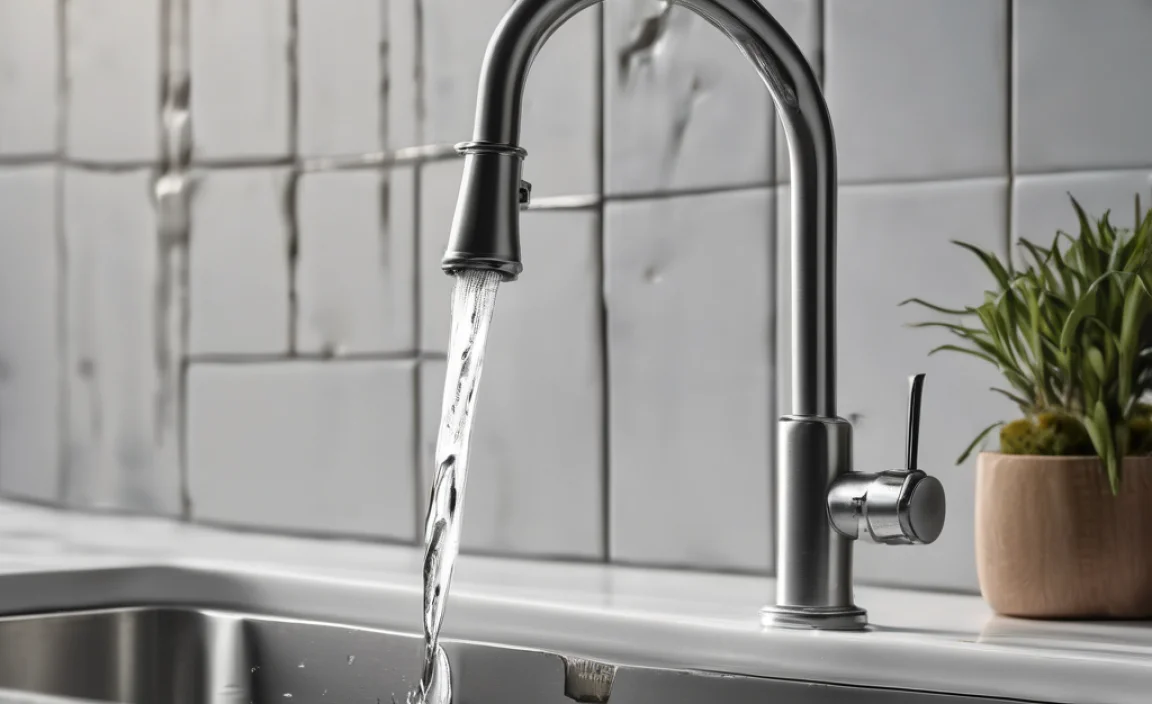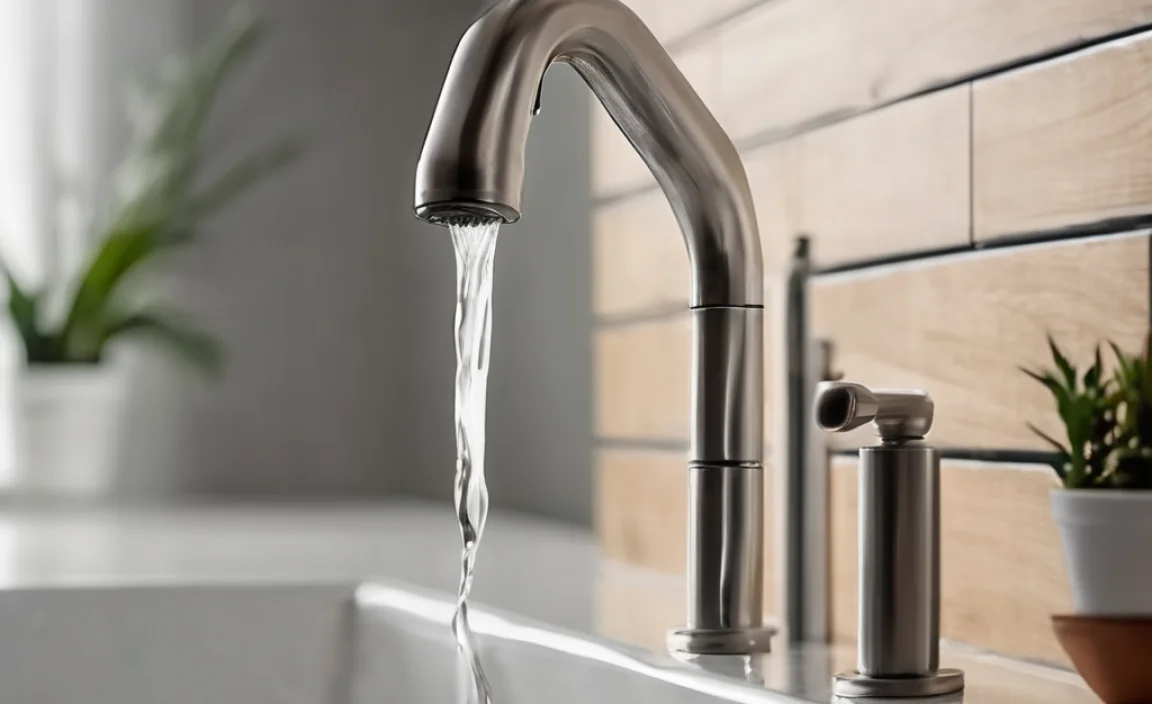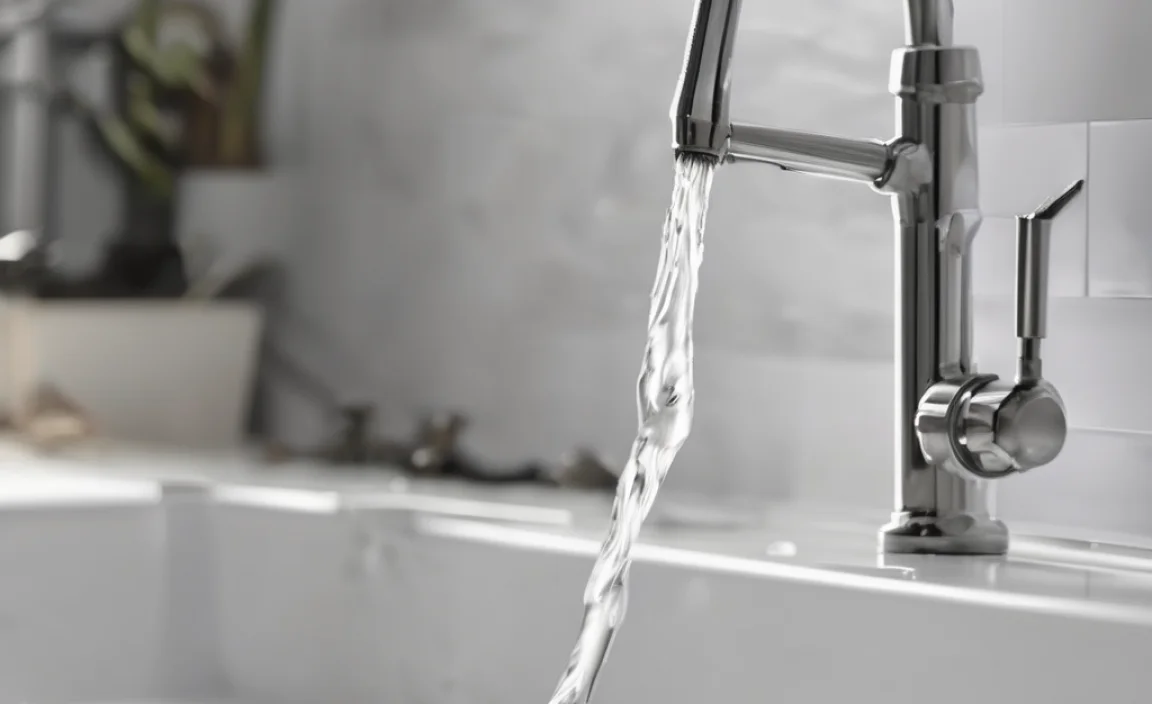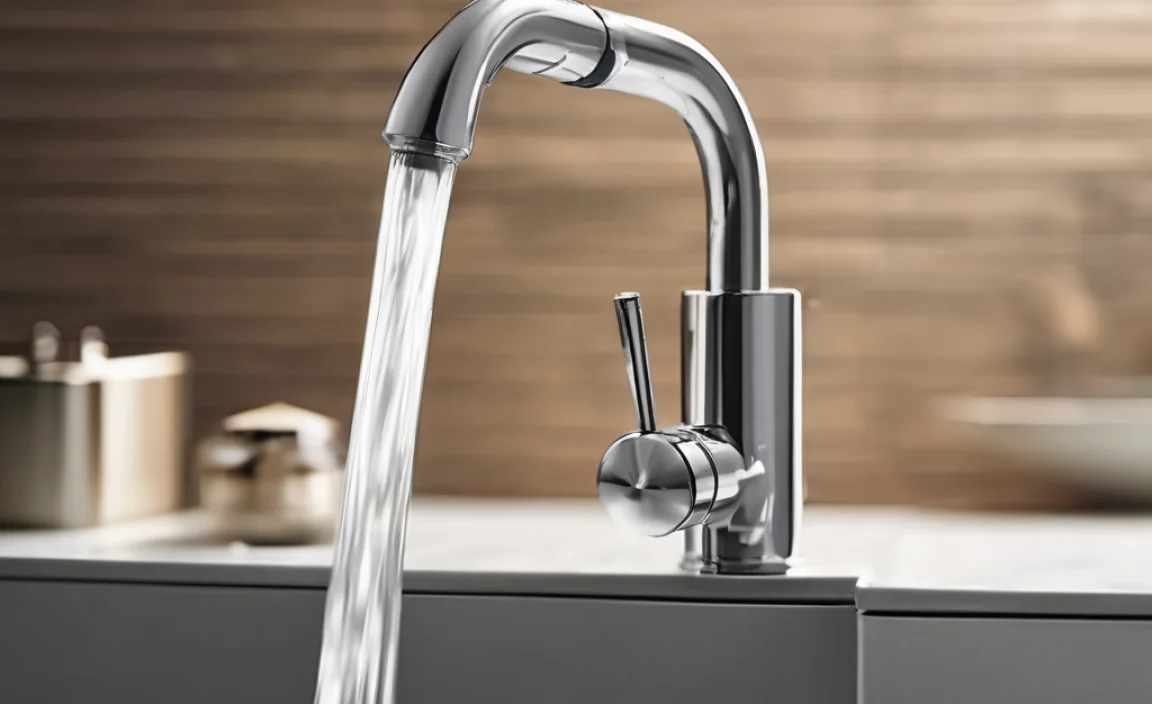Why is my faucet leaking at the base? Usually, it’s a worn-out O-ring or a loose cartridge. Sometimes, the packing nuts need tightening. Don’t worry! We’ll walk you through checking and fixing these common culprits. With a few simple steps, you can stop that annoying drip and save water.
Is your faucet dripping where it meets the sink? It’s a common problem, and you’re not alone! That little puddle can be super annoying and waste water.
The good news is, you can often fix it yourself. We’ll show you the most common reasons for a leaky faucet base and give you easy steps to solve each one. We will tackle O-rings, cartridges, and packing nuts. Grab a few tools, and let’s get started! You’ll have that drip stopped in no time.
Why is My Faucet Leaking at the Base? Common Culprits

A leaky faucet base can stem from several issues. Let’s explore the most common reasons:
- Worn-Out O-Rings: These small rubber rings create a seal between the faucet body and the base. Over time, they can dry out, crack, or flatten, leading to leaks.
- Loose Cartridge: Cartridge faucets use a cartridge to control water flow. If the cartridge loosens or the surrounding parts wear out, water can escape around the base.
- Corroded Valve Seat: The valve seat connects the faucet to the water supply. Corrosion can cause it to leak.
- Loose Packing Nut: The packing nut holds the faucet stem in place. If it loosens, water can seep out around the handle and base.
- High Water Pressure: Excessively high water pressure can put stress on the faucet’s internal components, causing leaks.
Tools You’ll Need

Before diving in, gather these essential tools:
- Adjustable Wrench: For loosening and tightening nuts.
- Screwdrivers (Phillips and Flathead): To remove handles and access internal parts.
- Penetrating Oil: To loosen stubborn nuts and bolts.
- New O-Rings: To replace worn-out seals.
- New Cartridge (if needed): To replace a faulty cartridge.
- Plumber’s Grease: To lubricate parts for smooth operation.
- Clean Cloths or Sponges: To clean up water and debris.
- Basin Wrench: Helpful for reaching nuts in tight spaces under the sink (optional).
- Safety Glasses: To protect your eyes.
Step-by-Step Guide to Fixing a Leaky Faucet Base

Follow these steps to diagnose and fix your leaky faucet:
Step 1: Turn Off the Water Supply
Before you do anything, shut off the water supply to the faucet. Look for shut-off valves under the sink. Turn both the hot and cold water valves clockwise until they’re completely closed. If you don’t have individual shut-off valves, you’ll need to turn off the main water supply to your house. This is usually located in the basement or near the water meter.
Step 2: Protect the Sink
Place a towel or cloth over the sink to protect it from scratches and dropped tools. This also helps to catch any small parts that might fall during the repair process.
Step 3: Identify the Faucet Type
Different faucets have different designs. Common types include:
- Compression Faucets: These have separate hot and cold water handles.
- Cartridge Faucets: These have a single handle that moves up and down for flow and side to side for temperature.
- Ball Faucets: These also have a single handle that rotates on a ball mechanism.
- Ceramic Disc Faucets: These have a single lever that moves up and down and side to side, similar to cartridge faucets.
Knowing your faucet type will help you understand how it’s assembled and how to disassemble it correctly.
Step 4: Disassemble the Faucet
Follow these steps to disassemble your faucet:
- Remove the Handle: Look for a screw on the handle. It might be hidden under a decorative cap. Use a screwdriver to remove the screw and then gently pull the handle off.
- Remove the Faucet Body: Depending on the faucet type, you may need to unscrew the faucet body from the base. Use an adjustable wrench to loosen the nut that holds the faucet body in place.
- Identify the Leaking Component: Once you’ve disassembled the faucet, inspect the O-rings, cartridge, valve seat, and packing nut for signs of wear or damage.
Step 5: Replace Worn-Out O-Rings
If you find worn-out O-rings, follow these steps to replace them:
- Remove the Old O-Ring: Use a small screwdriver or pick to carefully remove the old O-ring. Be careful not to scratch the surrounding surfaces.
- Clean the Area: Clean the area where the O-ring sits with a clean cloth. Remove any debris or corrosion.
- Install the New O-Ring: Lubricate the new O-ring with plumber’s grease. This will help it slide into place and create a better seal. Gently stretch the O-ring over the faucet stem and position it in the groove.
Step 6: Tighten the Packing Nut
If the packing nut is loose, follow these steps to tighten it:
- Locate the Packing Nut: The packing nut is located behind the handle, around the stem of the faucet.
- Tighten the Nut: Use an adjustable wrench to gently tighten the packing nut. Be careful not to overtighten it, as this can damage the faucet.
- Test for Leaks: Turn the water supply back on and check for leaks around the base of the faucet. If the leak persists, tighten the packing nut a little more.
Step 7: Replace the Cartridge (If Necessary)
If the cartridge is faulty, follow these steps to replace it:
- Remove the Retaining Clip: Use a pair of pliers to remove the retaining clip that holds the cartridge in place.
- Pull Out the Old Cartridge: Gently pull the old cartridge straight out of the faucet body.
- Install the New Cartridge: Line up the new cartridge with the faucet body and push it into place. Make sure it’s fully seated.
- Replace the Retaining Clip: Reinstall the retaining clip to secure the new cartridge.
Step 8: Reassemble the Faucet
Once you’ve replaced the necessary parts, reassemble the faucet in the reverse order of disassembly. Make sure all parts are properly aligned and securely tightened.
Step 9: Test for Leaks
Turn the water supply back on and check for leaks around the base of the faucet, the handle, and the spout. If you see any leaks, tighten the connections or replace any additional worn parts.
Troubleshooting Tips

Here are some additional tips to help you troubleshoot your leaky faucet:
- Stubborn Nuts: If you have trouble loosening a nut, apply penetrating oil and let it sit for a few minutes before trying again.
- Corroded Parts: If you find corroded parts, clean them with a wire brush or replace them if necessary.
- Water Pressure: If you suspect high water pressure is causing the leak, install a pressure regulator on your main water line.
Maintaining Your Faucet to Prevent Future Leaks

Regular maintenance can prevent future leaks and extend the life of your faucet:
- Inspect Regularly: Check your faucet for leaks and signs of wear at least twice a year.
- Lubricate Moving Parts: Apply plumber’s grease to the O-rings and cartridge to keep them lubricated.
- Clean Aerator: Clean the aerator (the screen at the tip of the faucet) regularly to remove mineral deposits and debris.
- Avoid Harsh Cleaners: Use mild soap and water to clean your faucet. Avoid harsh chemicals that can damage the finish and internal components.
When to Call a Plumber
While many faucet leaks can be fixed with DIY methods, there are times when it’s best to call a professional plumber:
- Extensive Corrosion: If the faucet is heavily corroded, it may be difficult to disassemble and repair.
- Broken Pipes: If you discover broken pipes or other plumbing issues, it’s best to have a plumber handle the repairs.
- Persistent Leaks: If you’ve tried all the DIY solutions and the leak persists, it’s time to call a plumber.
Cost of DIY vs. Hiring a Plumber
The cost of fixing a leaky faucet yourself is typically much lower than hiring a plumber. Here’s a breakdown:
| Expense | DIY Cost | Plumber Cost |
|---|---|---|
| Parts (O-rings, Cartridge) | $5 – $20 | $10 – $30 (plus service fee) |
| Tools (if needed) | $0 – $30 (if you need to buy a wrench or screwdriver) | $0 (plumber provides tools) |
| Labor | $0 (your time) | $75 – $200 per hour |
| Total | $5 – $50 | $85 – $230+ |
As you can see, DIY repairs can save you a significant amount of money. However, if you’re not comfortable working on plumbing or if the problem is complex, hiring a plumber is the best option.
FAQ About Leaky Faucets
Here are some frequently asked questions about leaky faucets:
Why does my faucet only leak when the water is running?
This often indicates a problem with the valve seat or cartridge. When the water is off, the pressure is equalized, and the leak stops. When the water is running, the pressure difference causes the leak to appear.
Can a leaky faucet increase my water bill?
Yes, even a small drip can waste a significant amount of water over time. A constantly dripping faucet can add dollars to your water bill each month.
Is it safe to ignore a leaky faucet?
No, ignoring a leaky faucet can lead to more serious problems, such as water damage, mold growth, and increased water bills. It’s best to fix the leak as soon as possible.
How do I know if I need to replace the entire faucet?
If the faucet is heavily corroded, has multiple leaks, or is very old, it may be more cost-effective to replace it. Also, if replacement parts are difficult to find, a new faucet might be the better option.
What is plumber’s grease, and why should I use it?
Plumber’s grease is a waterproof lubricant that helps to create a watertight seal and prevent corrosion. It’s used to lubricate O-rings, cartridges, and other moving parts in a faucet. This ensures smooth operation and extends the life of the components.
How do I find the right replacement parts for my faucet?
Take the old parts with you to the hardware store or plumbing supply store. The staff can help you find the correct replacements. Alternatively, look for the faucet’s model number (usually found on the faucet body or in the installation manual) and search online for replacement parts.
What if tightening the packing nut doesn’t stop the leak?
If tightening the packing nut doesn’t stop the leak, the packing material itself may be worn out. You can replace the packing material by removing the packing nut, wrapping new packing material around the faucet stem, and then reassembling the nut.
Conclusion
Fixing a leaky faucet base is a manageable DIY project. You can stop that annoying drip by identifying the cause, gathering the right tools, and following our step-by-step instructions. Remember to turn off the water supply first and take your time. Regular maintenance and prompt repairs will keep your faucets in good working order and save you money in the long run. If you encounter any difficulties or are unsure about any step, don’t hesitate to call a professional plumber. You’ve got this!

